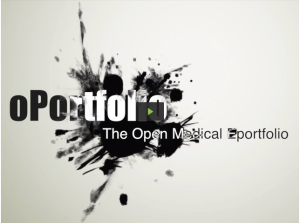It’s been a while since I blogged, but that doesn’t mean that nothing has been happening. I continue to participate in the RCP ePortfolio group with our next meeting coming up in July so please pass on anything you want me to feedback to them. Also, the teams behind Meducation and Podmedics have joined forces and launched a kickstarter to start developing Oportfolio: a free, open source ePortfolio, designed by doctors for use from medical school to retirement. Is this a game-changer? It could be….
All doctors need a way to log their achievements and learning. But an ePortfolio should be more than a collection of paperwork mandated for an appraisal or revalidation. It should support an individual in a constant process of self-reflection and improvement, and enhance something that is at the heart of learning – a relationship. The day when trainees and supervisors talk with enthusiasm and joy about their ePortfolio will be a happy one. I can’t wait to see this happen, but looking around at the software available across all specialities and all levels of training it feels a long way off. Why?
Money, money, money
One of the biggest barriers to change is constrained resources. We all know there is not much cash around at the moment in the NHS, and education in particular has suffered. Trainees have complained that the ePortfolio they use is not good value for money, but there is a limited amount that the Colleges (who hold the purse strings) can invest. So how much does the ePortfolio cost?

Photo credit: Images_of_Money http://www.taxbrackets.org/(Creative Commons)
In 2012 the NES ePortfolio (the biggest provider) cost it’s customers (Royal Colleges,the Foundation Programme etc) over £600,000. That was just one year. Good software costs money: it is created by talented professionals whose time and expertise is valuable. Putting a number on what good value is for the ePortfolio would be arbitrary However, if the users think it’s not good value, then it isn’t. They don’t value it, and therefore are less likely to engage with it. Disaster.
Due to the current way in which medical ePortfolios are funded, the only way to make them better, add features and speed up the development of the app would be to pour lots of money in. This is because the funding model depends on the customers (Colleges) individually specifying changes and paying for them in terms of developers’ time. These costs are on top of the day to day running costs. Unless this funding model radically changes, NES will never be able to deliver the kind of ePortfolio doctors are clamouring for. The team at NES have been fantastic in engaging with trainees and encouraging calls for change, but they are constrained by their location in an NHS Scotland Health Board and their lack of power over their own organisational and financial structures.
Don’t be shackled to the past
An important point made by Ben, a NES developer on an open Linked.in thread is that trainees only see one part of structure of the ePortfolio. There is a lot behind the sterile pages of mini-cexs, in terms of levels of access, account types, administration and data reporting. But the counter-question to this is, is that where we should be directing our money? Should we be paying for complicated layers of access structures, or should we trade this for better functionality? It is time for a fundamental shift in our conception of an ePortfolio, putting the learner at the centre. We have the opportunity to re-imagine what an ePortfolio could be and mustn’t let the structure of the current system dominate our thinking.
Open source – what’s all the fuss about?
Some are fearful of open source projects but there is already precedent in the NHS for open source software; for clinicians working directly with software developers to iteratively create things of beauty. If you have not seen OpenEyes before, click and behold! OpenEyes even holds patient data securely, so any alarmist worries about trainee data in an open source system can stop right here. It is fantastic to see new, agile ways of working emerging as successful – and anything has to be better than the NHS’s previous track record on IT projects!
Oportfolio
The Oportfolio team are creating an open source ePortfolio. This means the code will be open for anyone to use. They are not in it for the money. Their motives (paraphrased by me after many conversations with Ed and Jeremy at NHS Hackdays and online) are:
- a wish to help those who work in the NHS (for the ultimate benefit of patients)
- an interest in how technology can support education
- a passion for creating beautiful software.
Oportfolio will available to any doctor in the NHS, including those who are currently not affiliated to a College and therefore have no ePortfolio at all. The potential gains to the NHS are huge in terms of money, and doctor-time. More intangible benefits include: trainee and educator happiness; and more fulfilling postgraduate training.
Ultimately, happier, more reflective, better educated and informed doctors give better patient care. And that’s something you can’t put a price on.
So whether Oportfolio becomes the best thing since sliced bread and is adopted by all healthcare professionals in the NHS, or whether it is never adopted but creates pressure for change in the current systems that can no longer be ignored, it will have been a success.
The plan is for the end product to be free to users, but to get started they need a little seed money. I’ve just put my money where my mouth is to help get it off the ground. I hope you do the same.
What can you do?
- Add your comments to this site
- Tweet about #Oportfolio and follow for news
- Help fund the Oportfolio by joining the kickstarter
- Sign up by email for news of the Oportfolio
- Join the Googlegroup and add your ideas
- Listen to the Digital Doctor podcast where I discuss ePortfolios in medicine with the Digital Doctor team








